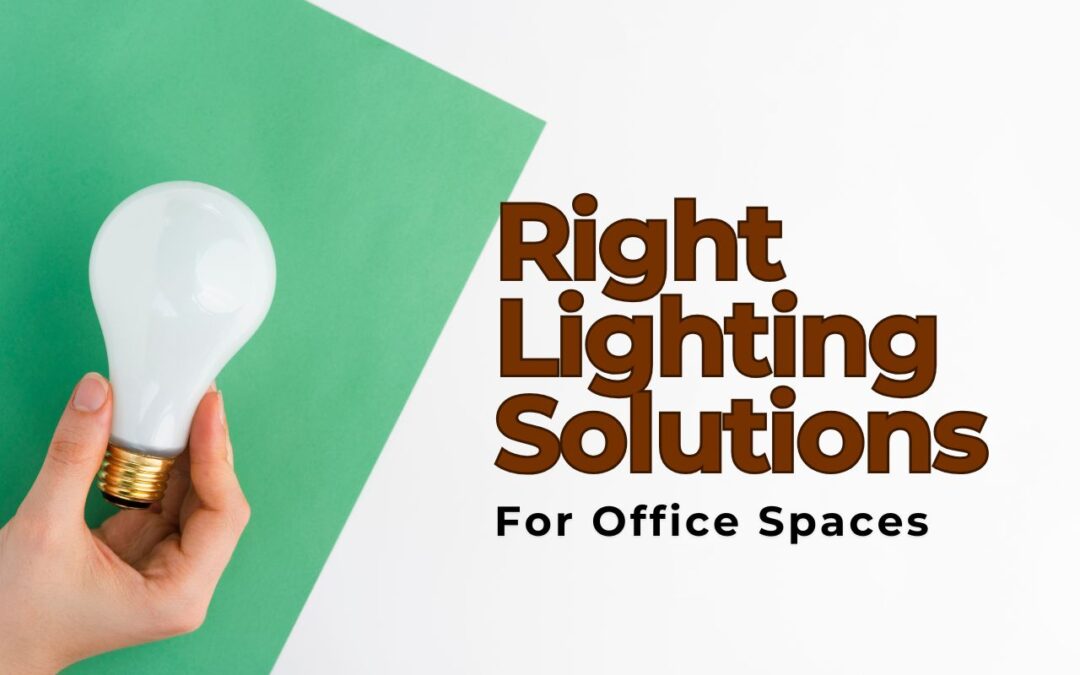Lighting is often underestimated when it comes to office design, but its impact on employee productivity, mood, energy consumption, and even company image is profound. Selecting the right lighting solutions for your office space goes far beyond choosing a few ceiling fixtures. It’s about understanding how light interacts with your work environment, how it supports different tasks, and how it contributes to the overall well-being of your team.
In this detailed guide, we’ll explore how to choose the right lighting for your office, the science behind effective lighting, types of lighting, design strategies, and common pitfalls to avoid—all with the goal of helping you create a more efficient and inspiring workspace.
Why Lighting Matters in Office Spaces
Lighting affects nearly every aspect of how we function in a work environment. From the moment we step into the office, the light around us begins to shape our mood, alertness, and ability to focus.
Lighting and Productivity
Numerous studies have proven that poor lighting can reduce productivity by up to 20%. In contrast, natural and well-balanced artificial lighting significantly enhances concentration and performance. Workers in offices with adequate daylight report fewer headaches, reduced eye strain, and better sleep quality—factors directly linked to job satisfaction and efficiency.
Lighting and Employee Health
Inadequate lighting, particularly flickering fluorescent bulbs or dim corners, can lead to fatigue, migraines, and long-term vision issues. Bright, cool light during the day can keep employees alert and awake, while overly warm or dim lighting can encourage drowsiness. The circadian rhythm, our body’s natural internal clock, is also influenced heavily by exposure to certain types of light at specific times of day.
Lighting and Energy Efficiency
Lighting typically accounts for about 20% to 40% of a building’s total energy usage. Choosing the right lighting solution can drastically reduce this number. Efficient lighting design not only conserves energy but also slashes operational costs in the long run.
Understand the Types of Lighting for Offices
To create an effective lighting plan, it’s essential to understand the three main categories of lighting in any office environment:
1. Ambient Lighting
This is the general, overall lighting that fills a room. It ensures the office is evenly lit and provides safe, navigable spaces. Ceiling-mounted fixtures or recessed lights often serve this purpose.
2. Task Lighting
As the name suggests, task lighting is focused illumination for specific jobs. Think of desk lamps, under-cabinet lighting, or adjustable lights for workstations. It’s essential for tasks that require precision, such as reading, writing, or computer work.
How to Start a Petrol Pump Business in India: Complete Guide for 2025
3. Accent Lighting
While often overlooked, accent lighting adds a layer of visual interest to office spaces. It can highlight architectural features, artwork, or branding elements, reinforcing a professional and aesthetically pleasing work environment.
A well-designed office lighting plan combines all three types to enhance functionality, comfort, and visual appeal.
Factors to Consider When Choosing Office Lighting
1. The Nature of Work
Different roles require different lighting setups. For example, graphic designers or architects may need brighter, high-CRI (Color Rendering Index) lighting to discern colors accurately, while data analysts working on screens might benefit from anti-glare and diffused light.
Ask yourself:
- Do your employees spend most of their time on screens?
- Is there paperwork or manual work involved?
- Are there collaborative or creative tasks that need flexible lighting?
Tailoring lighting to job functions increases both efficiency and satisfaction.
2. Natural Light Availability
Maximizing daylight is a smart move for any office. Natural light has been linked to improved mood, energy, and sleep quality. If your office has access to large windows, use it strategically. However, natural light should be supplemented appropriately to account for overcast days and late work hours.
You also need to consider glare control—direct sunlight can cause screen reflections and heat buildup, so a balance between natural light and controlled artificial light is ideal.
3. Color Temperature and Mood
Light has color tones measured in Kelvin (K):
- Cooler temperatures (5000K-6500K) mimic daylight and are great for productivity.
- Neutral light (3500K-4500K) suits conference rooms or shared spaces.
- Warmer light (2700K-3000K) creates a cozy ambiance, ideal for break rooms or relaxation zones.
Cooler light boosts alertness and is recommended during morning and early afternoon hours. Warmer tones may be better for end-of-day wind-down.
4. Glare and Reflection
One of the most common complaints in modern offices is screen glare. Direct overhead lighting or poorly positioned desk lamps can create annoying reflections on monitors, leading to eye fatigue. Choosing fixtures with diffusers or adjustable angles helps reduce this issue. Also, matte screen protectors and anti-glare coatings on windows are excellent add-ons.
5. Adjustability and Control
A one-size-fits-all lighting plan rarely works. People have different sensitivities to light. Adjustable lighting—whether it’s dimmable fixtures, task lamps, or smart lighting systems—allows employees to customize their light levels based on comfort and time of day.
This adaptability is particularly important in open office layouts where lighting needs can vary widely across workstations.
Lighting Design Strategies for Office Spaces
Layer Your Lighting
Instead of relying on a single source of light, combine multiple layers:
- Overhead ambient lighting to fill the room
- Task lighting for individual desks
- Accent lighting for aesthetics or branding
This layered approach creates depth and avoids overly bright or overly dim zones in the office.
Use Zoning
Divide your office into lighting zones based on activity:
- Bright zones for focus-intensive work
- Softer lighting for collaboration spaces
- Warm and relaxing light in break rooms
Zoning supports the functional needs of the space and contributes to employee well-being.
Consider Ergonomics
Lighting ergonomics means placing fixtures in a way that supports healthy posture and visual comfort. Desk lights should be positioned opposite to the dominant hand to avoid shadows. Avoid placing lights directly above computer monitors or behind them.
Incorporate Lighting into Interior Design
Light affects how we perceive colors and space. The interplay between wall colors, furniture finishes, and lighting should be considered in your overall office design. For example, reflective surfaces can amplify light, while darker materials may require more illumination.
Common Lighting Mistakes to Avoid
- Ignoring Task Needs: General lighting alone can’t meet specific work requirements. Always pair it with dedicated task lights where needed.
- Over-lighting the Space: More light doesn’t mean better performance. Excessive brightness can cause visual fatigue and discomfort.
- Neglecting Color Rendering: Lights with poor CRI make everything look dull or off-colored, which can negatively affect tasks that depend on color accuracy.
- Using Outdated Fixtures: Older lighting systems often consume more energy and produce less efficient illumination. Upgrading improves both cost and quality.
- Failing to Maintain Lighting Systems: Dirty or damaged fixtures reduce output. Regular maintenance ensures your lighting stays effective and safe.
Future Trends in Office Lighting
Office right lighting solutions are evolving to align with smarter workplaces and health-focused design.
Human-Centric Lighting
This approach supports the body’s circadian rhythms by mimicking natural daylight throughout the day. For instance, cool blue light in the morning transitioning to warmer tones later in the day can promote alertness and relaxation at appropriate times.
Dynamic Lighting Systems
These systems automatically adjust brightness and color temperature based on time of day, occupancy, or daylight availability. This not only conserves energy but also enhances comfort.
Sensor-Driven Lighting
Motion and occupancy sensors ensure the right lighting solutions are used only when needed, leading to significant energy savings.
Statistics that Highlight the Impact of Lighting
- 68% of employees complain about the lighting in their offices. Most say it’s either too dim or too harsh.
- Natural light improves mood and energy levels in 78% of workers, according to surveys focused on office design and well-being.
- Workplaces with good daylight access report a 15% reduction in absenteeism.
- Energy-efficient lighting upgrades can reduce lighting-related energy consumption by 30-60%.
- Employees exposed to poor lighting are 23% more likely to experience eye strain and fatigue.
Final Thoughts
Choosing the right lighting solutions for office spaces is not merely about visibility. It’s about creating an environment that supports the people who work there—mentally, physically, and emotionally. When thoughtfully designed, lighting can drive productivity, foster innovation, and boost morale.
Start by assessing your current lighting setup. Observe how light behaves in different areas, talk to your team about their preferences, and consider how your lighting could better support your organizational goals. A well-lit office is a small investment with massive returns.
Remember: the right lighting solutions doesn’t just help people see—it helps them thrive.













